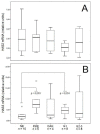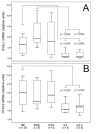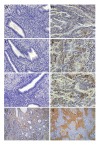Hyaluronan synthases (HAS1-3) and hyaluronidases (HYAL1-2) in the accumulation of hyaluronan in endometrioid endometrial carcinoma
- PMID: 20875124
- PMCID: PMC2956733
- DOI: 10.1186/1471-2407-10-512
Hyaluronan synthases (HAS1-3) and hyaluronidases (HYAL1-2) in the accumulation of hyaluronan in endometrioid endometrial carcinoma
Abstract
Background: Hyaluronan accumulation correlates with the degree of malignancy in many solid tumor types, including malignant endometrial carcinomas. To elucidate the mechanism of hyaluronan accumulation, we examined the expression levels of the hyaluronan synthases (HAS1, HAS2 and HAS3) and hyaluronidases (HYAL1 and HYAL2), and correlated them with hyaluronan content and HAS1-3 immunoreactivity.
Methods: A total of 35 endometrial tissue biopsies from 35 patients, including proliferative and secretory endometrium (n = 10), post-menopausal proliferative endometrium (n = 5), complex atypical hyperplasia (n = 4), grade 1 (n = 8) and grade 2 + 3 (n = 8) endometrioid adenocarcinomas were divided for gene expression by real-time RT-PCR, and paraffin embedded blocks for hyaluronan and HAS1-3 cytochemistry.
Results: The mRNA levels of HAS1-3 were not consistently changed, while the immunoreactivity of all HAS proteins was increased in the cancer epithelium. Interestingly, HAS3 mRNA, but not HAS3 immunoreactivity, was increased in post-menopausal endometrium compared to normal endometrium (p = 0.003). The median of HYAL1 mRNA was 10-fold and 15-fold lower in both grade 1 and grade 2+3 endometrioid endometrial cancers, as compared to normal endometrium (p = 0.004-0.006), and post-menopausal endometrium (p = 0.002), respectively. HYAL2 mRNA was also reduced in cancer (p = 0.02) and correlated with HYAL1 (r = 0.8, p = 0.0001). There was an inverse correlation between HYAL1 mRNA and the epithelial hyaluronan staining intensity (r = -0.6; P = 0.001).
Conclusion: The results indicated that HYAL1 and HYAL2 were coexpressed and significantly downregulated in endometrioid endometrial cancer and correlated with the accumulation of hyaluronan. While immunoreactivity for HASs increased in the cancer cells, tumor mRNA levels for HASs were not changed, suggesting that reduced turnover of HAS protein may also have contributed to the accumulation of hyaluronan.
Figures



Similar articles
-
Expression of hyaluronan synthases (HAS1-3) and hyaluronidases (HYAL1-2) in serous ovarian carcinomas: inverse correlation between HYAL1 and hyaluronan content.BMC Cancer. 2009 May 12;9:143. doi: 10.1186/1471-2407-9-143. BMC Cancer. 2009. PMID: 19435493 Free PMC article.
-
Hyaluronan accumulation is associated with reduced hyaluronidase expression in renal cell carcinoma, with CD44, HAS1, and HYAL2 emerging as prognostic markers.J Pathol Clin Res. 2025 Jul;11(4):e70035. doi: 10.1002/2056-4538.70035. J Pathol Clin Res. 2025. PMID: 40528762 Free PMC article.
-
Decreased hyaluronidase 1 expression is associated with early disease recurrence in human endometrial cancer.Gynecol Oncol. 2015 Apr;137(1):152-9. doi: 10.1016/j.ygyno.2015.01.525. Epub 2015 Jan 10. Gynecol Oncol. 2015. PMID: 25584766
-
Biology of hyaluronan: Insights from genetic disorders of hyaluronan metabolism.World J Biol Chem. 2015 Aug 26;6(3):110-20. doi: 10.4331/wjbc.v6.i3.110. World J Biol Chem. 2015. PMID: 26322170 Free PMC article. Review.
-
Hyaluronan and hyaluronan synthases: potential therapeutic targets in cancer.Curr Drug Targets Cardiovasc Haematol Disord. 2005 Feb;5(1):3-14. doi: 10.2174/1568006053005056. Curr Drug Targets Cardiovasc Haematol Disord. 2005. PMID: 15720220 Review.
Cited by
-
Activation of Matrix Hyaluronan-Mediated CD44 Signaling, Epigenetic Regulation and Chemoresistance in Head and Neck Cancer Stem Cells.Int J Mol Sci. 2017 Aug 24;18(9):1849. doi: 10.3390/ijms18091849. Int J Mol Sci. 2017. PMID: 28837080 Free PMC article. Review.
-
Inhibition of hyaluronic acid degradation pathway suppresses glioma progression by inducing apoptosis and cell cycle arrest.Cancer Cell Int. 2023 Aug 11;23(1):163. doi: 10.1186/s12935-023-02998-4. Cancer Cell Int. 2023. PMID: 37568202 Free PMC article.
-
Proximal and distal regulation of the HYAL1 gene cluster by the estrogen receptor α in breast cancer cells.Oncotarget. 2016 Nov 22;7(47):77276-77290. doi: 10.18632/oncotarget.12630. Oncotarget. 2016. PMID: 27764788 Free PMC article.
-
Tissue distribution and subcellular localization of hyaluronan synthase isoenzymes.Histochem Cell Biol. 2014 Jan;141(1):17-31. doi: 10.1007/s00418-013-1143-4. Epub 2013 Sep 22. Histochem Cell Biol. 2014. PMID: 24057227
-
Upregulation of HYAL1 expression in breast cancer promoted tumor cell proliferation, migration, invasion and angiogenesis.PLoS One. 2011;6(7):e22836. doi: 10.1371/journal.pone.0022836. Epub 2011 Jul 28. PLoS One. 2011. Retraction in: PLoS One. 2022 Nov 7;17(11):e0277500. doi: 10.1371/journal.pone.0277500. PMID: 21829529 Free PMC article. Retracted.
References
-
- Connelly PJ, Alberhasky RC, Christopherson WM. Carcinoma of the endometrium. III. Analysis of 865 cases of adenocarcinoma and adenoacanthoma. Obstet Gynecol. 1982;59:569–575. - PubMed
Publication types
MeSH terms
Substances
LinkOut - more resources
Full Text Sources
Other Literature Sources

